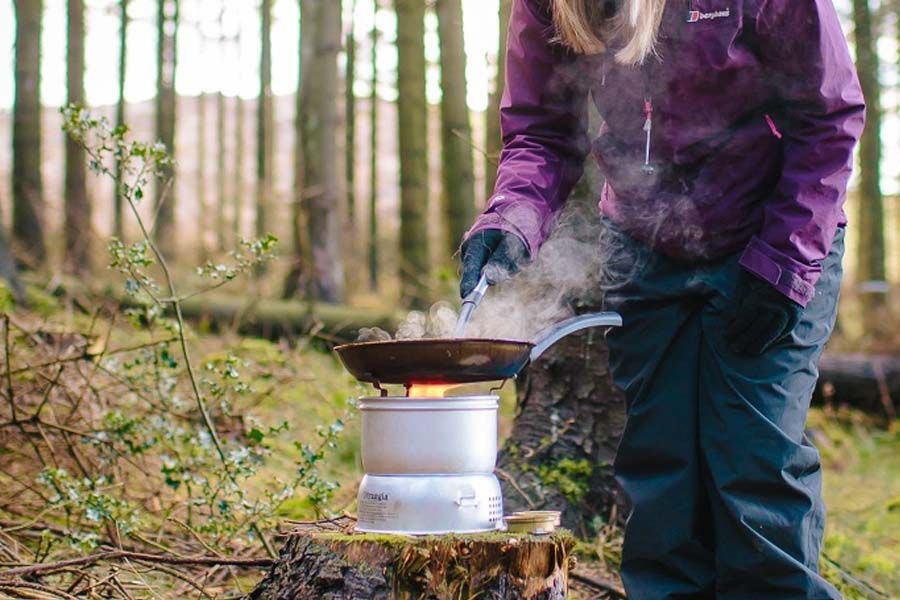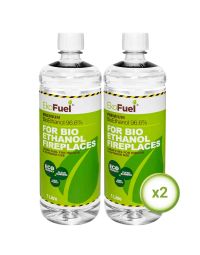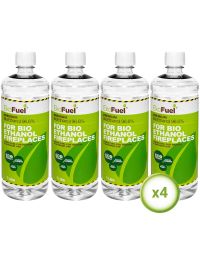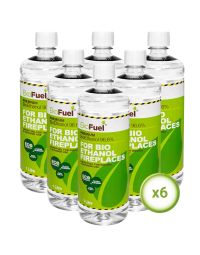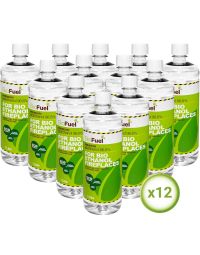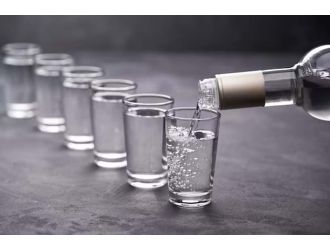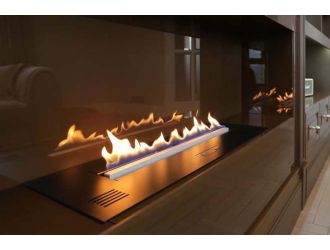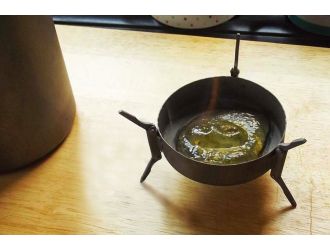As you may be aware methylated spirit, the traditionally used fuel for alcohol camping stoves in the UK has been outlawed by European legislation as of July 2013. It was deemed unsafe because of its high methanol content, which was in the recipe as the denaturant to ensure the alcohol was unfit for human consumption.
Here at Ekofuel we have developed a safer denatured alcohol that can be used in both indoor ethanol fireplaces and outdoor camping stoves. Our recipe has been produced using the fermentation method of ethanol production instead of the chemically produced route, making it a Bio-ethanol.
We are now probably the largest distributor of bio-ethanol fuel for fireplaces in the UK.
The Setup and Tests
The equipment
As part of the development of our biofuel, we decided to test its performance on the long-established Trangia. The kit selected was the Trangia UL-27 seen below. A slightly different pot with a larger capacity was used in place of the Trangia pot.
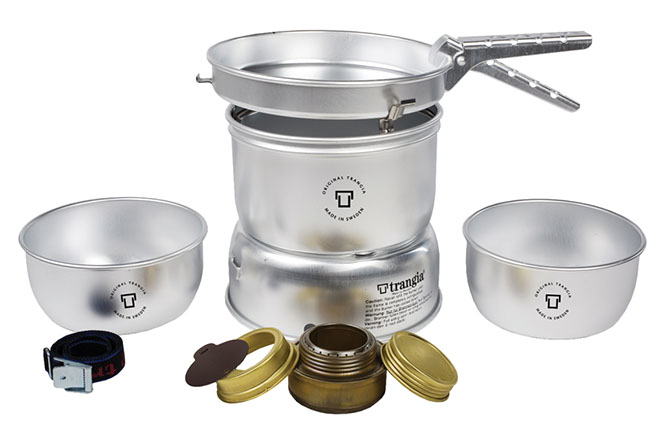
Watered-down ethanol?
A quick search relating to liquid camping stove rules on the internet will return a lot of information about homemade alcohol stoves and whether water should be added to meths to reduce sooting. It seems a common conception that 10% water should be added to the meths to reduce sooting. What it not clear, is whether this is 10% by weight or 10% by volume as there is quite a large difference.
For my money, fuels should not be watered down. Why? Well, from a scientific view point water has a very high specific heat, higher than metals. What this means is that not only are the fuels less powerful per gram, but the fuels also need to heat up and evaporate the water added to the fuel! This wastes precious energy which could be used to heat the food or water in the pan.
On this basis, I decided to base my tests on neat, undiluted fuels in the Trangia.
The Tests
When testing the fuel I was focusing on the following issues:
- •Boil time -1litre of water from 21C to 100C (using data logger).
- •The amount of sooting on the pans – recorded via photographs.
- •Fuel consumption. Measured with electronic balance and data logger during the burning trail.
The photo below shows the rig used. The times quoted are from the very second that the Trangia was first lit. Approx 10-15 secs was lost putting the pan and lid into position, this is included in the times quoted. This accurately recorded the temperature the water reached 100C rather than a rolling boil.

In testing the Trangia I found that the pans heavily sooted with a high separation distance between burner and pan. This will be discussed below. In light of this, I tested an adaptation to the Trangia to improve the burning of the fuel, the results of which are also discussed below.
The Findings
As stated above, during the course of the tests I made a number of adaptions to the set-up of the test apparatus in order to reduce the height between the fuel and the bottom of the pan.
After conducting various tests under laboratory conditions I found the following. I have separated these finings between the original set-up and my modified set up. The primary difference between these 2 being the different separation distance between the fuel and the pan.
Standard Trangia Setup
Boil times- Using Ekofuel, the times taken to heat up 1litre of water from 21C to 100C varied between 8mins 58 secs and over 10mins. The difference was due to the changing separation distances between the burner and the underside of the pot. The faster time was achieved with the pot in the high setting (as in the setup photo Figure 1) and the Trangia sat in its standard position.
When conducting further tests I also found that adding 12.5% by weight of water had a dramatic effect on the boil times. Boil time increased to 11mins 24secs.
In order to test the lowest separation distance between burner and pan (without modifying the typical Trangia set up), I changed to a Trangia 1lt pan with 700mls of water in it. The boil time for this low setting was 10mins 48secs.Amount of Sooting*- For me this is a key issue. What a user wants is relatively soot free pans and easy cleaning before putting away the stove. At the start of the testing I ran the Trangia on meths purchased at our local hardware store. I ran it pure and I ran it mixed with water (10% by weight). On both occasions the underside of the pans were heavy in soot, the 10% water mix slightly less sooty than the 100% meths.
Initially the results from using Ekofuel on the Trangia were no better. Figure 2 below shows the first result taken using pure Ekofuel when a boil time of 8mins 58secs was achieved. Figure 3 shows the sooting with 12.5wt% water. Although slightly better than the pure Ekofuel, I would still class it as a lot of soot.


Fuel consumption- Fuel consumption to heat the 1 litre of water from 21C to 100C was around 25g for pure Ekofuel and for the water diluted fuel it was around to 27g both in the high separation setting. For the low separation setting, the fuel consumption was less, normalised out for 1 lt of water, it was around 21g suggesting that the low clearance setting is more slightly more efficient that the high clearance setting.
Modified Trangia Setup
Boil Times- Using the modified Trangia setup the best boil time was 7mins 42 secs in the high clearance setting. An improvement over the standard Trangia of boil times. Water boiled in approx 14% less time than the standard Trangia arrangement. Again the fastest time was achieved in the high pot position. The low clearance setting was not investigated as reasonable results were achieved with the standard Trangia at this setting.
Amount of Sooting*- Here’s where the big improvements were noticeable. Figure 4 below shows the underside of the pan used with the modified Trangia in the high clearance setting.
Contrast this with Figure 2 and the improvement is obvious. The small amount of sooting in our opinion would be classed as acceptable. When 10% water was added, the improvements were even better see Figure 5 where the pans are clean.


Fuel consumption- Pretty similar to those exhibited by the unmodified Trangia maybe slightly more efficient at around 22 to 23g, but more research would need to be conducted to prove this.
Conclusions
In conclusion Ekofuel can be burnt cleanly in a Trangia style camping stove, and with a few modifications to the stove design can burn cleaner than the traditional meths fuel. What the industry needs now is alcohol burners capable of burning bio-ethanol cleanly.
- •A litre of Ekofuel will heat approx 43-44 litres of water from 21C to 100C in a standard Trangia.
- •Ekofuel bioethanol is suitable for use in alcohol stoves, it is a high powered alcohol fuel and can yield fast boil times. Whether the pans will soot or not, is a function of the alcohol burner design. The better the burner the less the sooting.
- •The low separation distance between pan and burner leads to cleaner pans, but a significant decrease in boil time as a result of reduced rate of fuel consumption. This low separation distance appeared to be more efficient that the high clearance setting.
- •Fast boil times are achieved by having a large separation distance using the standard Trangia setup.
* Please remember that these results are under laboratory conditions with little or no breeze. Outdoor conditions may reduce the amount of sooting.
